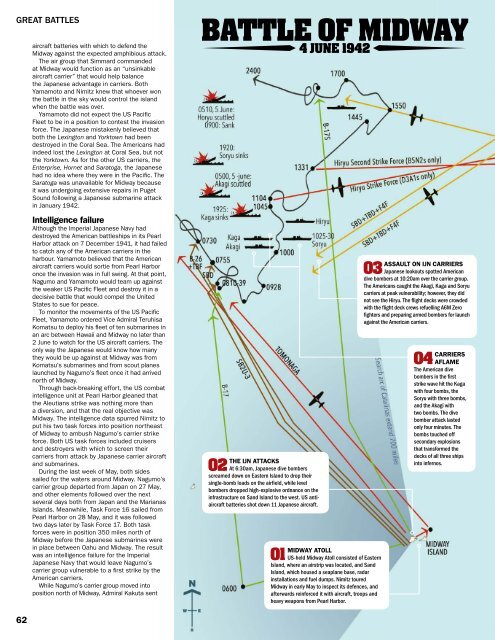Create successful ePaper yourself
Turn your PDF publications into a flip-book with our unique Google optimized e-Paper software.
GREAT BATTLES<br />
aircraft batteries with which to defend the<br />
Midway against the expected amphibious attack.<br />
The air group that Simmard commanded<br />
at Midway would function as an “unsinkable<br />
aircraft carrier” that would help balance<br />
the Japanese advantage in carriers. Both<br />
Yamamoto and Nimitz knew that whoever won<br />
the battle in the sky would control the island<br />
when the battle was over.<br />
Yamamoto did not expect the US Pacific<br />
Fleet to be in a position to contest the invasion<br />
force. The Japanese mistakenly believed that<br />
both the Lexington and Yorktown had been<br />
destroyed in the Coral Sea. The Americans had<br />
indeed lost the Lexington at Coral Sea, but not<br />
the Yorktown. As for the other US carriers, the<br />
Enterprise, Hornet and Saratoga, the Japanese<br />
had no idea where they were in the Pacific. The<br />
Saratoga was unavailable for Midway because<br />
it was undergoing extensive repairs in Puget<br />
Sound following a Japanese submarine attack<br />
in January 1942.<br />
Intelligence failure<br />
Although the Imperial Japanese Navy had<br />
destroyed the American battleships in its Pearl<br />
Harbor attack on 7 December 1941, it had failed<br />
to catch any <strong>of</strong> the American carriers in the<br />
harbour. Yamamoto believed that the American<br />
aircraft carriers would sortie from Pearl Harbor<br />
once the invasion was in full swing. At that point,<br />
Nagumo and Yamamoto would team up against<br />
the weaker US Pacific Fleet and destroy it in a<br />
decisive battle that would compel the United<br />
States to sue for peace.<br />
To monitor the movements <strong>of</strong> the US Pacific<br />
Fleet, Yamamoto ordered Vice Admiral Teruhisa<br />
Komatsu to deploy his fleet <strong>of</strong> ten submarines in<br />
an arc between Hawaii and Midway no later than<br />
2 June to watch for the US aircraft carriers. The<br />
only way the Japanese would know how many<br />
they would be up against at Midway was from<br />
Komatsu’s submarines and from scout planes<br />
launched by Nagumo’s fleet once it had arrived<br />
north <strong>of</strong> Midway.<br />
Through back-breaking effort, the US combat<br />
intelligence unit at Pearl Harbor gleaned that<br />
the Aleutians strike was nothing more than<br />
a diversion, and that the real objective was<br />
Midway. The intelligence data spurred Nimitz to<br />
put his two task forces into position northeast<br />
<strong>of</strong> Midway to ambush Nagumo’s carrier strike<br />
force. Both US task forces included cruisers<br />
and destroyers with which to screen their<br />
carriers from attack by Japanese carrier aircraft<br />
and submarines.<br />
During the last week <strong>of</strong> May, both sides<br />
sailed for the waters around Midway. Nagumo’s<br />
carrier group departed from Japan on 27 May,<br />
and other elements followed over the next<br />
several days both from Japan and the Marianas<br />
Islands. Meanwhile, Task Force 16 sailed from<br />
Pearl Harbor on 28 May, and it was followed<br />
two days later by Task Force 17. Both task<br />
forces were in position 350 miles north <strong>of</strong><br />
Midway before the Japanese submarines were<br />
in place between Oahu and Midway. The result<br />
was an intelligence failure for the Imperial<br />
Japanese Navy that would leave Nagumo’s<br />
carrier group vulnerable to a first strike by the<br />
American carriers.<br />
While Nagumo’s carrier group moved into<br />
position north <strong>of</strong> Midway, Admiral Kakuta sent<br />
BATTLE OF MIDWAY<br />
4 JUNE 1942<br />
THE IJN ATTACKS<br />
02 At 6:30am, Japanese dive bombers<br />
screamed down on Eastern Island to drop their<br />
single-bomb loads on the airfield, while level<br />
bombers dropped high-explosive ordnance on the<br />
infrastructure on Sand Island to the west. US antiaircraft<br />
batteries shot down 11 Japanese aircraft.<br />
MIDWAY ATOLL<br />
01 US-held Midway Atoll consisted <strong>of</strong> Eastern<br />
Island, where an airstrip was located, and Sand<br />
Island, which housed a seaplane base, radar<br />
installations and fuel dumps. Nimitz toured<br />
Midway in early May to inspect its defences, and<br />
afterwards reinforced it with aircraft, troops and<br />
heavy weapons from Pearl Harbor.<br />
ASSAULT ON IJN CARRIERS<br />
03 Japanese lookouts spotted American<br />
dive bombers at 10:20am over the carrier group.<br />
The Americans caught the Akagi, Kaga and Soryu<br />
carriers at peak vulnerability; however, they did<br />
not see the Hiryu. The flight decks were crowded<br />
with the flight deck crews refuelling A6M Zero<br />
fighters and preparing armed bombers for launch<br />
against the American carriers.<br />
04 CARRIERS<br />
AFLAME<br />
The American dive<br />
bombers in the first<br />
strike wave hit the Kaga<br />
with four bombs, the<br />
Soryu with three bombs,<br />
and the Akagi with<br />
two bombs. The dive<br />
bomber attack lasted<br />
only four minutes. The<br />
bombs touched <strong>of</strong>f<br />
secondary explosions<br />
that transformed the<br />
decks <strong>of</strong> all three ships<br />
into infernos.<br />
62


















